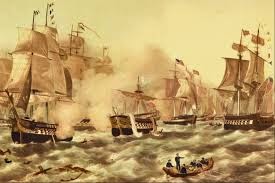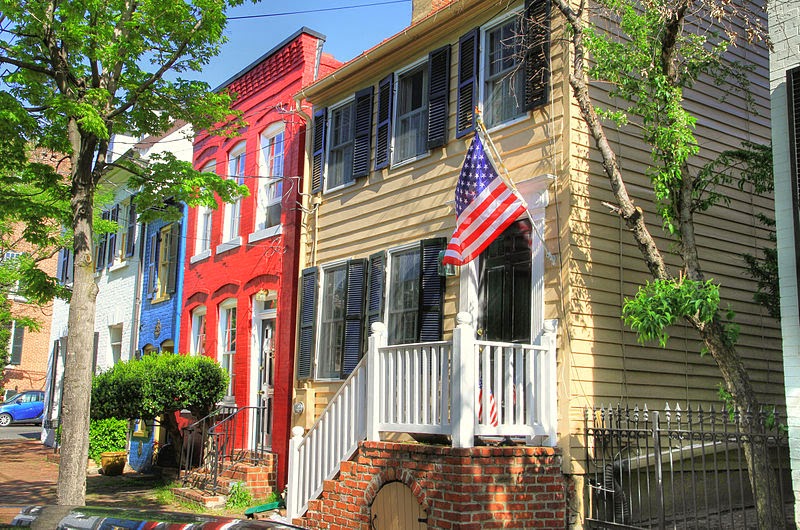THE BRITISH BURN WASHINGTON CITY (WAR OF 1812)
Victoria here. After about two years of fighting here and there, nothing about the War of 1812 had been settled.
For our post on the beginning of that war, click here.
“Capture of the City of Washington”,
Based on an engraving from Rapin’s History of England,
published by J. and J. Gundee, Albion Press, London, 1815.
After April 1814, when Napoleon had abdicated the first time (see our post here), many of the battle-hardened British troops were sent to North America. Great Britain planned to finish the War with the United States, which had so far been fought in a variety of places, including the high seas, in Canada, in U.S. territories, the disputed west where many Native Americans allied themselves with the British, and in the Gulf of Mexico. None of the battles, whether skirmishes or out and out facing off of warships, was decisive.
Battle of Lake Erie, Sept. 10, 1813
Once the British troops reached North America, one group landed in Canada and set out to defend and attack from the north, they were effective in limiting any U.S. victories there. A second group sailed into Chesapeake Bay with the objective of capturing Washington City, the fledgling capital of the young U.S.A., and Baltimore, a busy port and commercial center just about 40 miles north of Washington.
The British troops routed the Americans at the Battle of Bladensburg, just outside Washington, on August 24, 1814. The capital was expecting an invasion, and as the fleeing U. S. militia men fled through the streets, most residents evacuated.
Dolley Madison, by Gilbert Stuart
One cannot tell the story about the burning of the White House without including the wife of President James Madison, Dolley Payne Madison (1768-1849). In the absence of her husband who was elsewhere conferring with generals, she was left alone at the White House. She had been working with the architects to furnish the building, only finished a few years previously. Though continually urged to flee, Dolley would not leave without the monumental painting of first President, George Washington which had to be removed from its frame and the canvas rolled up for its survival.
George Washington by Gilbert Stuart
Both of the above paintings are in the White House Collection
For a detailed account “How Dolley Madison Saved the Day” from the Smithsonian Institution, click here. One of the ironies of the story is that the full-length portrait of Washington was a copy, probably by Stuart himself, of the painting commissioned in 1796 as a gift for the Marquess of Lansdowne, the British Prime Minister (known then as Earl of Shelburne) who helped to conclude the Revolutionary War with the independence of the U.S.A. It now hangs in the National Portrait
Gallery, Washington, D. C. while the version saved by Mrs. Madison is in the White House. For the whole story of the Lansdowne Portrait, click here
Gallery, Washington, D. C. while the version saved by Mrs. Madison is in the White House. For the whole story of the Lansdowne Portrait, click here
During August 24 and 25, the British burned many of Washington’s government buildings, including the Capitol and the Treasury. When an arsenal exploded prematurely and killed several dozen of the British troops and a freak thunderstorm broke out bringing high winds and heavy rain, the British troops withdrew. Though many of little Washington City’s buildings were in ruins, most of the residences and many businesses were intact. When the Madisons returned, they took up residence in the Octagon House, still standing just a block or two from the White House.
The Octagon House Museum
1799 New York Avenue NW, Washington, D.C.
The unfinished United States Capitol Building was set aflame and only parts of it survived.
U. S. Capitol in August 1814 after the fire
For all the details of the fire and the rebuilding, click here.
&
nbsp;
nbsp;
Many historians say the British burned Washington in retaliation for the burning and sacking of the Canadian city of York (now Toronto, Ontario) by the Americans in 1813. Accounts can be found showing that many buildings were saved in Washington because the troops were well disciplined and had been ordered by their commanders, Admiral Cockburn and Major General Ross, to spare civilian lives and structures.
Queen Street, Alexandria, Virginia
In late August, British ships laid siege to Alexandria, a thriving commercial city on the Virginia side of the Potomac River just south of Washington. The city, which had no defenses, surrendered and the British took large stores of flour, tobacco, wine, and sugar from the warehouses. After several days of occupation, the British withdrew on September 2, 1814, leaving all buildings intact.
After the British troops left the immediate Washington vicinity, they turned their attention to taking Baltimore, to the north, We will report on that battle in a few days








I have read — in varius places– that the burning of Washington, DC was a foolish move by the British as it unified the country which had been torn between those who wanted to return to English rule and those who wanted to continue as an independent nation.
Some have called it the second war of Independence.
Reports of who was winning seems to depend on whose history you read, though most agree that there wasn't a clear cut winner.
Yes, no clear cut winner. But Canada was protected from U.S. ambitions of annexation, and the Native Americans lost a powerful ally in the British. The end of the Napoleonic Wars meant impressment of sailors on U.S. ships ended too, for all practical purposes.